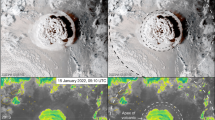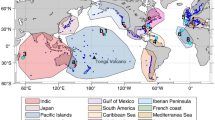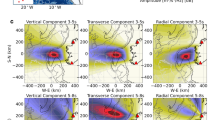Abstract
The Earth undergoes continuous oscillations, and free oscillation peaks have been consistently identified in seismic records in the frequency range 2–7 mHz (refs 1, 2), on days without significant earthquakes. The level of daily excitation of this ‘hum’ is equivalent to that of magnitude 5.75 to 6.0 earthquakes3,4, which cannot be explained by summing the contributions of small earthquakes1,3. As slow or silent earthquakes have been ruled out as a source for the hum4 (except in a few isolated cases5), turbulent motions in the atmosphere or processes in the oceans have been invoked3,6,7,8 as the excitation mechanism. We have developed an array-based method to detect and locate sources of the excitation of the hum. Our results demonstrate that the Earth's hum originates mainly in the northern Pacific Ocean during Northern Hemisphere winter, and in the Southern oceans during Southern Hemisphere winter. We conclude that the Earth's hum is generated by the interaction between atmosphere, ocean and sea floor, probably through the conversion of storm energy to oceanic infragravity waves that interact with seafloor topography.
This is a preview of subscription content, access via your institution
Access options
Subscribe to this journal
Receive 51 print issues and online access
$199.00 per year
only $3.90 per issue
Buy this article
- Purchase on Springer Link
- Instant access to full article PDF
Prices may be subject to local taxes which are calculated during checkout




Similar content being viewed by others
References
Suda, N., Nawa, K. & Fukao, Y. Earth's background free oscillations. Science 279, 2089–2091 (1998)
Tanimoto, T., Um, J., Nishida, K. & Kobayashi, N. Earth's continuous oscillations observed on seismically quiet days. Geophys. Res. Lett. 25, 1553–1556 (1998)
Tanimoto, T. & Um, J. Cause of continuous oscillations of the Earth. J. Geophys. Res. 104, 28723–28739 (1999)
Ekström, G. Time domain analysis of Earth's long-period background seismic radiation. J. Geophys. Res. 106, 26483–26493 (2001)
Beroza, G. & Jordan, T. H. Searching for slow and silent earthquakes using free oscillations. J. Geophys. Res. 95, 2485–2510 (1990)
Kobayashi, N. & Nishida, N. Continuous excitation of planetary free oscillations by atmospheric disturbances. Nature 395, 357–360 (1998)
Fukao, Y., Nishida, K., Suda, N., Nawa, K. & Kobayashi, N. A theory of the Earth's background free oscillations. J. Geophys. Res. 107, doi:10.1029/2001JB000153 (2002)
Watada, S. & Masters, G. Oceanic excitation of the continuous oscillations of the Earth. Eos 82, F871 (2001)
Nishida, K. & Kobayashi, N. Statistical features of Earth's continuous free oscillations. J. Geophys. Res. 104, 28741–28750 (1999)
Roult, G. & Crawford, W. Analysis of ‘background’ free oscillations and how to improve resolution by subtracting the atmospheric pressure signal. Phys. Earth Planet. Inter. 121, 325–338 (2000)
Rhie, J. & Romanowicz, B. Detection and location of potential sources of background low frequency surface wave energy. Eos 83(Fall Meet. Suppl.), abstr. S12A–1184 (2002)
von Seggern, D. Relative location of seismic events using surface waves. Geophys. J.R. Astron. Soc. 26, 499–513 (1972)
Rouland, D., Condis, C., Parmentier, C. & Souriau, A. Previously undetected earthquakes in the Southern Hemisphere from long-period Geoscope data. Bull. Seismol. Soc. Am. 82, 2448–2463 (1992)
Rost, S. & Thomas, C. Array seismology: Method and applications. Rev. Geophys. 40, doi:10.1029/2000RG000100 (2002)
Friedrich, A., Kruger, F. & Klinge, K. Ocean-generated microseismic noise located with the GRFO array. J. Seismol. 2, 47–64 (1998)
Schulte-Pelkum, V., Earle, P. S. & Vernon, F. L. Strong directivity of ocean-generated seismic noise. Geochem. Geophys. Geosyst. 5, doi:10.1029/2003GC000520 (2004)
Ekström, G., Nettles, M. & Abers, G. A. Glacial earthquakes. Science 302, 622–624 (2003)
Nishida, K., Kobayashi, N. & Fukao, Y. Origin of Earth's ground noise from 2 to 20 mHz. Geophys. Res. Lett. 29, doi:10.1029/2001GL013862 (2002)
Tanimoto, T. Jet stream, roaming ocean waves, and ringing Earth. Eos 84(Fall Meet. Suppl.), abstr. S12F–04 (2003)
Webb, S., Zhang, X. & Crawford, W. Infragravity waves in the deep ocean. J. Geophys. Res. 96, 2723–2736 (1991)
Munk, W., Snodgrass, F. & Gilbert, F. Long waves on the continental shelf: an experiment to separate trapped and leaking modes. J. Fluid Mech. 20, 529–554 (1964)
Webb, S. & Crawford, W. Long-period seafloor seismology and deformation under ocean waves. Bull. Seismol. Soc. Am. 89, 1535–1542 (1999)
Webb, S. Broadband seismology and noise under the ocean. Rev. Geophys. 36, 105–142 (1995)
Ekström, G., Tromp, J. & Larson, E. Measurements and models of global surface wave propagation. J. Geophys. Res. 102, 8137–8157 (1997)
Committee for Implementation of a Seafloor Observatory Network for Oceanographic Research. Enabling Ocean Research in the 21st Century: Implementation of a Network of Ocean Observatories (Ocean Studies Board, National Academies Press, Washington DC, 2003)
Wielandt, E. & Streckeisen, G. The leaf spring seismometer: design and performance. Bull. Seismol. Soc. Am. 72, 2349–2367 (1982)
Dziewonski, A. M. & Anderson, D. L. Preliminary reference Earth model. Phys. Earth Planet. Inter. 25, 297–356 (1981)
Schimmel, M. & Paulssen, H. Noise detection and reduction of weak, coherent signals through phase-weighted stacks. Geophys. J. Int. 130, 497–505 (1997)
Acknowledgements
We thank the operators of the following seismic networks for making their data publicly available: BDSN (http://www.seismo.berkeley.edu), F-net (http://www.fnet.bosai.go.jp/freesia/index.html), IRIS (http://www.iris.edu) and TERRAscope. The Monthly Mean Global Surface Ocean Variables were obtained from the Physical Oceanography Distributed Active Archive Center (http://podaac.jpl.nasa.gov/poet). This work was partially supported by the NSF.
Author information
Authors and Affiliations
Corresponding author
Ethics declarations
Competing interests
The authors declare that they have no competing financial interests.
Supplementary information
Supplementary Methods and Figure legends
Detailed information on some methods we used for this research and detailed figure captions for supplementary figures. (DOC 39 kb)
Supplementary Figure 1
Illustration of stacking procedure. (PDF 49 kb)
Supplementary Figure 2
Comparison of stacking methods. (PDF 73 kb)
Supplementary Figure 3
Amplitude of array stack as a function of back azimuth and time for a day with an earthquake. (PDF 32 kb)
Supplementary Figure 4
Analysis of a detection during a quiet day (January 31, 2000) on the F-net array. (PDF 388 kb)
Supplementary Figure 5
Analysis of array response. (PDF 12 kb)
Supplementary Figure 6
Forward modeling of source distribution in azimuth for F-net. (PDF 18 kb)
Supplementary Figure 7
Forward modeling of source distribution in azimuth for BDSN. (PDF 18 kb)
Supplementary Figure 8
Results of forward modeling of stack amplitudes as a function of azimuth for F-net and BDSN for a distribution of sources concentrated over different continents. (PDF 23 kb)
Supplementary Figure 9
Results of forward modeling of stack amplitudes as a function of azimuth, for F-net and BDSN for a distribution of sources concentrated over selected oceanic areas. (PDF 13 kb)
Rights and permissions
About this article
Cite this article
Rhie, J., Romanowicz, B. Excitation of Earth's continuous free oscillations by atmosphere–ocean–seafloor coupling. Nature 431, 552–556 (2004). https://doi.org/10.1038/nature02942
Received:
Accepted:
Issue Date:
DOI: https://doi.org/10.1038/nature02942
This article is cited by
-
Seismic noise between 0.003 Hz and 1.0 Hz and its classification
Progress in Earth and Planetary Science (2023)
-
Progress of Research on the Earth’s Gravity Tides and its Application in Geodynamics in China
Pure and Applied Geophysics (2023)
-
Spatial and temporal variation of the ambient noise environment of the Sikkim Himalaya
Scientific Reports (2022)
-
Locating the Source Regions of the Single and Double-Frequency Microseisms to Investigate the Source Effects on HVSR in Site Effect Analysis
Journal of Earth Science (2022)
-
Urbanization effect on Hyderabad seismic station
Journal of Earth System Science (2022)
Comments
By submitting a comment you agree to abide by our Terms and Community Guidelines. If you find something abusive or that does not comply with our terms or guidelines please flag it as inappropriate.



